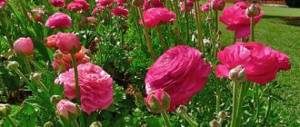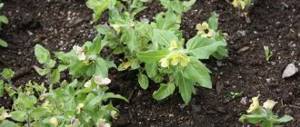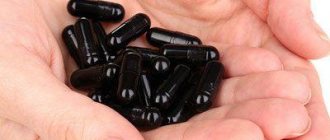Aconite (fighter) is a perennial herbaceous plant of the buttercup family, has more than 300 species, some of them are listed in the Red Book. The flowers of aconite are irregularly shaped and resemble a helmet with a lowered visor (hence the German name Eisenhut, literally “iron hat”). White, blue, yellow or lilac flowers are collected in a massive inflorescence up to 50 cm high. It blooms from mid-summer to the end of September.
Source: depositphotos.com
Aconite is very dangerous, which is reflected in the myths about its origin. The ancient Greeks believed that it grew where the poisonous saliva of a dog from the kingdom of the dead fell; The Scandinavians believed that the wrestler appeared at the site of the death of the god Thor from the bites of a poisonous snake.
Aconite is an extremely toxic plant; poisoning can be caused by all its parts, but the most toxic are the above-ground parts during the flowering period and the roots during the period of withering of the tops. Toxicity is associated with the presence of a number of alkaloids, mainly aconitine. The degree of toxicity depends on the type of plant, its age, place of growth and phase of the growing season. Aconite is used in folk medicine, although representatives of official medicine consider its use unacceptable in any form.
Chemical composition
Currently, the chemical composition of Aconite has not been fully studied. It is known that all parts of the plant contain alkaloids associated with aconitic acid, among which aconitine predominates.
The tubers of the plant contain approximately 0.18-4% of the total alkaloids of the aconitine group:
- Aconitine;
- Hypoaconitine;
- Mesoaconitin;
- Sasaakonitine;
- Getaconitine;
- Benzoylaconine.
Other alkaloids found were:
In addition to alkaloids, Aconite tubers also contain:
- Transaconitic acid;
- Daucosterol;
- Mesoinosidol (0.05%);
- Benzoic, citric, fumaric acids;
- Significant amount of sugar (9%);
- Resins;
- Saponins;
- Coumarins (0.3%);
- Linoleic, oleic, stearic, palmitic and myristic acids;
- Flavones;
- Starch.
The stems and leaves of Aconite contain tannins, the alkaloid aconitine, inositol, various trace elements (more than 20 types), ascorbic acid, flavonoids and other biologically active compounds.
Digitalis
Foxglove, the first mention of which dates back to 1543, received its interesting name due to the fact that the plant is similar in shape to a thimble. Unpretentious in care, foxglove is found in forests, mountains, gardens and feels great both in partial shade and in the sun, both on sandy and clay soils. But it is worth considering that no matter how beautiful the foxglove is, it is just as dangerous, being poisonous due to the content of glycosides in it. Moreover, the poison is present in all parts of the plant, including the seeds. At the same time, digitalis is one of the medicinal plants and is used in the treatment of heart diseases.
Useful properties of Aconite
In pharmaceutical doses, Aconite has an effect on the central nervous system and, in general, on the entire human body.
First of all, the use of Aconite is popular as an anesthetic for gout, sciatica, and neuralgia. It should also be noted that it has a beneficial effect on colds accompanied by high fever, in particular bronchitis and runny nose.
Sometimes doctors recommend it to patients in the form of a tincture, and externally in the form of ointments or liquid rubs to relieve pain. Self-treatment, without medical supervision, is highly not recommended.
They produce a homeopathic remedy Aconite, which is prepared from fresh flowering plants. It is often prescribed to patients for feverish conditions accompanying colds, flu, as well as for various pain syndromes. The homeopathic remedy Aconite is prescribed even for cardiac complaints, 5-10 drops 3-4 times a day. Patients take it at the first signs of a cold: sneezing and chills, in order to prevent influenza infection.
In folk medicine, Aconite is known more as a poisonous plant than a medicinal one. In ancient times, Aconite was used to smear the tips of spears and arrows, and the blades of swords. In ancient medical sources one can only find references to the use of Aconite for the treatment of eye diseases.
For the first time, homeopathy became interested in the properties of Aconite, and only after that the plant began to become widespread in folk medicine.
The main range of uses of Aconite are colds, rheumatism, various pain syndromes, gout, inflammation of the respiratory tract and digestive tract, insomnia.
Mostly in folk medicine, the use of Aconite is widespread in the form of alcohol tinctures, or wine with the addition of the plant.
Buttercup
Possessing beautiful bright leaves and attractive yellow flowers, buttercup is a widespread plant, growing mainly in central Russia. Unpretentious in care, having a developed root system, buttercup grows almost everywhere: in wastelands, fields, clearings, personal plots. The plant contains protoanemonin, a substance classified as poisonous. The caustic juice of buttercup, if it comes into contact with the skin, can cause burns; if it comes into contact with the oral mucosa, it causes laryngeal spasm and severe coughing, and if it gets into the eyes, it can cause short-term loss of vision.
Indications for use of Aconite
Preparations made from Aconite tubers are widely used for colds and as an analgesic for joint pain and inflammation of the trigeminal nerve.
Since Aconite is toxic, it has not found use in traditional medicine, but in folk medicine it is very much so. The beneficial properties of Aconite are used to treat the following diseases:
- Gout;
- Arthritis;
- Epilepsy;
- Osteochondrosis;
- External bruises;
- Convulsions;
- External sciatica;
- Paralysis;
- Headaches and migraines;
- Nervous disorders and depression;
- Excessive tearfulness;
- acute respiratory infections, sore throat and other colds and viral diseases;
- Nervous system disorder.
Aconite is also used as a diaphoretic, a means of accelerating hair growth, to avoid urine retention in the body, and for nosebleeds.
Contraindications
Aconite is an extremely poisonous plant, so it must be handled with care.
Under no circumstances should you increase the dosage of medicine based on Aconite. Aconite is strictly contraindicated for children.
You should be aware of the signs of Aconite poisoning:
- Itching all over the body and burning in the mouth;
- Profuse sweating;
- Chills;
- Nausea and vomiting, diarrhea;
- Numbness of the limbs;
- Slow breathing.
Within 20 minutes after poisoning with Aconite, death can occur as a result of collapse, so in no case should you hesitate, you must urgently take the patient to the hospital.
You should also know emergency measures for Aconite poisoning:
- Try to induce vomiting in the patient by giving him salt water to drink (for 1 glass - 1-2 tablespoons of salt);
- After cleansing the stomach, give the patient activated charcoal (shaken 20-30 g in water).
English yew
The seeds of this medium-sized tree, enclosed under the pulp of its red tender berries, are especially poisonous. This is what allows birds to safely feast on yew fruits. The tree is distributed in Europe, North Africa and South-West Asia. For humans, a lethal dose is 50 g of a toxic compound. Signs of poisoning include difficulty breathing, convulsions, and coma. Death occurs from cardiac arrest, sometimes so quickly that all the symptoms of intoxication do not have time to appear.
Home remedies from Aconite
Alcohol tincture of Aconite for cancer: take 1 tsp. roots of the plant, ground into powder, pour 0.5 liters of vodka and leave for 2 weeks in a dark place, shaking daily. Strain through cheesecloth.
Article on the topic: Crimean blackberry - beneficial properties, description
Treatment with tincture is as follows: 1 drop of tincture is mixed with 50 ml of water and taken 3 times a day before each meal. Every day add 1 drop of tincture, bringing the dosage to 10 drops 3 times a day. At this dose (10 drops), the tincture is taken for 10 days, after which they begin to gradually reduce the dosage, bringing the tincture to 1 drop 3 times a day. After this, you need to take a month's break and undergo treatment again. Thus, it is necessary to carry out 7 courses of treatment.
Alcohol tincture of Aconite for toothache, rheumatism, migraine: take 20 g of plant roots, pour in 5 liters of vodka and leave to infuse for one week. The tincture should have the color of strongly brewed tea.
For rheumatism, it is useful to rub this tincture into the sore spot, and then wrap yourself in flannel. For migraines and neuralgia, drink the tincture, gradually increasing the dosage from 1 tsp. up to 1 tbsp. l. For toothache, you can drip a drop of tincture onto the sore tooth.
Found an error in the text? Select it and press Ctrl + Enter.
We use the healing properties of the herb aconite for our health
Many people know the medicinal properties of the herb aconite or fighter, as it is also called. This herbaceous perennial has long been used for medical and household purposes. The plant is considered poisonous, but effectively heals any wounds, reduces inflammation, and has analgesic properties. Aconite has beautiful flowers, which are used as an additional remedy to fight cancer and heart pathologies.
White snake root
Eupatorium perfoliatum contains the slow-acting poison tremetol. It is known as perforated window sill (pierced-leaved). Grows on the North American continent. The route by which the poison enters the human body is interesting. After flowering, the resulting seeds are easily dispersed by the wind. They are eaten by livestock and the toxin is absorbed into meat and milk. The disease, which is often fatal, is called milk disease. At the beginning of the 19th century, a large number of immigrants died from this disease, and it is believed that the mother of American President Abraham Lincoln did not escape this fate.
The most poisonous plants have either beautiful flowers, eye-catching brightly colored berries, or a pleasant aroma. It is necessary to remember and be sure to explain to children that visible beauty is often deceptive, and the true essence of these plants is death.
Chemical composition of aconite
The plant has a rich composition, including a set of organic acids and phytoncides, alkaloids and essential oils. This complex of substances has a powerful antibacterial and analgesic effect.
The foliage and roots of aconite are saturated with the following alkaloids:
In addition to them, ephedrine, napallin, and sparteine were found in the plant. The rhizome is rich in resinous substances, daucosterol, and includes starchy compounds and saponins. Various acids were found in the fighter: citric, benzoic, fumaric. There are also many fatty acids: stearic, linoleic, palmitic, as well as oleic and myristic.
Leaf blades accumulate tannins, inositol, flavonoids and a whole list of minerals:
- Macroelements include potassium and calcium compounds, iron salts, and magnesium.
- Microelements include copper, chromium, zinc and manganese compounds. Also present are barium, nickel salts, boron, and selenium.
The composition of the fighter also includes carbohydrates, coumarin, mesoinosidol. All of them are indispensable for the human body.
Medicinal properties of the herb aconite
Various parts of the wrestler are saturated with vitamins, mineral salts, and alkaloids. Due to such a complex chemical composition, this plant is used to combat many ailments.
The alkaloids with which the herb is saturated have found their application in pharmacology. These substances are found in sedatives, pain relievers, and spasms. Alkaloids can stimulate the nervous system.
Wrestler is also added to medications to lower blood pressure, restore hormone levels and against coughs.
Aconite is the plant that will relieve any cold.
It is also worth noting that aconite contains many flavonoids, thanks to which the plant treats malignant tumors. These substances inhibit the growth of tumors, eliminate inflammation, and protect the body during radiation therapy. Due to the tannin content, the grass is used as a bactericidal agent. The juice from the leaves can stop bleeding and heal wounds.
Aconite extracts are also added to diuretics. Wrestler is used to heal ulcers and get rid of sexually transmitted infections. The coumarin contained in the perennial has a beneficial effect on the cardiovascular system.
Delphinium
Known as larkspur, delphinium is a frequent visitor to the garden plot. And not everyone knows that a plant that contains alkaloids is dangerous and poisonous. Eating parts of delphinium has a depressing effect on the functioning of the most important organs and systems of the body. It is interesting that it is the horticultural species of delphinium that are considered to be the most poisonous. Honey collected from the flowers of the plant is poisonous to humans and causes the death of bees.
The use of aconite in folk medicine
Many people do not know what aconite cures. This is truly a unique plant. Infusions prepared from the roots treat benign tumors, lung diseases, including tuberculosis and even asthma. The herbaceous perennial has proven itself well for eliminating sclerosis and epileptic seizures.
Aconite tincture is used externally to combat infectious skin lesions, abscesses, ulcers, and to eliminate psoriasis and eczema.
Tincture for the treatment of cardiovascular diseases
To prepare a medicine for pathologies of the heart and blood vessels you need:
- 10 g dried wrestler roots;
- 1 liter of vodka (without additives).
The crushed rhizome is placed in a jar and filled with vodka. You can also use 60% alcohol. It is recommended to infuse the product for at least 72 hours in a dark place, then strain. The tincture is ready. Take 2 drops three times a day, about 30 minutes before meals, with slightly warm water.
Tincture for the treatment of migraines and toothaches
Aconite extract has the ability to relieve pain, so it is used to prepare a remedy for toothaches or migraines.
To prepare the product you need:
- 0.5 l of vodka;
- 20 g of aconite rhizome (must be dried, not fresh).
The rhizome of the wrestler should be finely chopped and placed in a jar. Then pour the raw material with alcohol-containing liquid. Be sure to keep in a warm, dark place for 7 days.
For migraine 1 tsp. medicinal tincture of aconite is rubbed into the head before bed. For toothache, the remedy is applied and rubbed into the area where it is localized. If the body tolerates this tincture well, then the dosage can be increased to 1 tbsp. l. The course of therapy is no more than 1 month.
Tincture for external use
An alcoholic extract from the rhizome of aconite is effective against psoriasis, dermatitis, and erysipelas. It helps eliminate allergic manifestations and various rashes that appear on nerves. Melanoma and malignant formations in the epidermis are treated with this infusion.
Article on the topic: Rough cornflower - useful properties, description
To receive the funds you must take:
- 1 liter of pure alcohol, or regular vodka;
- 40 g of dried borax root (crushed).
Pour small pieces of roots with alcohol (vodka) and leave for at least a week. The color of the liquid will become similar to brewed tea. For any skin problems, an alcohol extract is applied to the affected areas. They are covered with polyethylene on top and wrapped in a towel. I practice this therapy for no more than 30 days.
Infusion for the treatment of duodenal ulcers
To make a medicinal tincture, you will need dried herb root (20 g) and 0.6 liters of vodka. The plant must be crushed and filled with liquid. Keep it in the pantry for a week out of direct sunlight. Use aconite tincture 3 tablespoons per day.
Decoction for washing wounds and boils
The rhizome of the wrestler has bactericidal properties, so tinctures of it are used to heal wounds and treat abscesses. You need to take 15 g of dried rhizome, chop it and pour 25 ml of boiling water. Keep on fire for 20 minutes, then strain. Rinse the affected areas with cooled infusion up to 4 times a day.
Reviews of treatment with Djungarian aconite.
Anatoly
I had to get acquainted with this tincture for a sad reason - I was diagnosed with stomach cancer. The tincture went well for me, I lasted 3 courses, now I’m in remission, I’m gathering strength for a new course. God bless everyone!
Maria, Nakhodka
I bought aconite for my dad when he was diagnosed with kidney cancer. We completed 3 courses, in between there were 4 chemo treatments, followed all the recommendations of the herbalist, drank elderberry syrup and liver herbal tea. Dad is alive - that's the most important thing! I even became happier.
He tolerated taking the tincture easily, there were no side effects, unlike chemotherapy, of course. Thank you for your smart advice, I only rely on herbs.
Alla V, Stavropol
I had to buy Djungarian aconite not because of my good life; they discovered a tumor in my chest. Of course, I want to live, I managed to find this tincture, I read about it. She does not exclude chemistry; everyone should be treated, just not in combination. I had to go through surgery and chemotherapy. I saw aconite in the same course and withstood everything. The cancer has receded and I am now in remission. I don’t know for how long, but I will fight, including with the help of herbs.
Aconite is used not only for oncology, but also for benign tumors, male sexual disorders, gout, joint diseases, cysts and polyps, immunodeficiencies; the tincture can and should be used externally as rubs and compresses. This method does not exclude internal use.
Collection and preparation of raw materials from aconite
All manipulations with the medicinal fighter, even preparation, are carried out with gloves that protect hands from the penetration of poison. Both the rhizomes of the plant and its stems with foliage are suitable for obtaining medicines. The roots are dug up at the very end of summer or early autumn. Then they are thoroughly washed from the soil and dried at a temperature not exceeding 30 0 C.
Dried roots should be stored in a place where there is no direct sunlight and no high humidity.
Aconite foliage must be collected in June-July before the plant blooms.
At this time, the most useful components accumulate in the plates.
When harvesting, you need to ensure that the plants are not infected with insects or any diseases.
The leaves are dried only in the shade and stored in glass jars. Containers should be kept out of the reach of children. After handling aconite, it is recommended to wash your hands thoroughly.
Side effects and contraindications for use
Aconite includes poisonous compounds. Therefore, it has a number of restrictions that must be adhered to.
It is not recommended to use products with aconite:
- those under 18 years of age;
- during pregnancy, during lactation;
- in case of individual immunity to the drug;
- with drug or alcohol addiction.
Before taking aconite, you should consult a doctor.
It is strictly forbidden to exceed the recommended dosage, otherwise it will lead to poisoning. When the first symptoms appear, you should seek medical help. Side effects during treatment with aconite include dizziness, dry mouth, and vomiting. In more severe cases, it manifests itself in the form of loss of consciousness and a strong increase in body temperature.
If you want to forget about illnesses once and for all, then infusions and decoctions based on aconite are what you need. Proper preparation and administration of the products will allow you to achieve the desired results in a short time.
Water hemlock
Cicuta Virosa contains cicutotoxin. Another name is poisonous wekh, poisonous parsnip. It is considered the most poisonous plant on the North American continent.
Hemlock is completely poisonous, but the maximum concentration of toxin is found in the roots. The plant is most dangerous in the spring when sap flow begins. Convulsions, nausea, vomiting, trembling of limbs, clouding of consciousness, abdominal pain - these are the main symptoms of hemlock poisoning. Death occurs within a few hours from respiratory failure or cardiac failure.
Poisonous and healing properties of the aconite plant
Aconite, or fighter, is a genus of poisonous grass that grows in Europe, Asia and North America. The plant has been known among the people for a long time; it has the following names: black root, fighter-root, wolf's potion, king-grass, iron helmet and others. Tibetan monks value grapple for its healing properties. But the plant is better known as a strong poison, so it should be handled very carefully.
Aconite (fighter) capulaceae
Rosary Pea
Rosary Pea contains the poison abrin. The plant is known as dangerous arus, crab eyes. An elegant liana came to us from Indonesia. The seeds are shaped like a bright red pea with a striking black spot. Used by Aboriginal people to make beads. Rosaria, if not poisonous, could join the list of the most beautiful plants in the world.
The strength of abrin is 75 times higher than, for example, ricin. One such “bead” (3 micrograms of poison) is capable of ending a human life. It’s definitely not worth making beads from these peas: you can get severe poisoning even from contact with the poison contained on the tip of a needle.
Main types of aconite
There are more than 300 species of fighter in nature. Its height ranges from 50 to 150 cm. The color of the flowers can be blue, purple, less often yellow and white. The grass loves sunny, well-fertilized places with sufficient moisture. The flowering period begins at the end of June and lasts until the end of summer. The most famous types of aconite are:
- capillary borer (ornamental plant with violet-blue or white flowers);
- oak borer (wild herb with yellow inflorescence);
- paniculata (wild and garden plant with flowers of blue, blue and deep purple);
- woolly wrestler (loves thickets and bushes) and others.
Blackroot, which grows in the wild, is highly poisonous. But its decorative types lose their toxic properties and will decorate any front garden.
White Crow
Actaea alba is also one of the most interesting plants in the world. It is rich in carcinogenic toxins. It also has another name: doll eyes. Sweet berries, white in the middle with a black dot, really resemble a doll's eyes and are very attractive to children. The almost instantaneous effect of the poison affects the heart muscle. Death often occurs.
The chemical composition of aconite and its healing properties
The species of a given representative of the buttercup family determines its composition. The genus is united by the presence of a strong poison in the rhizome - aconitine. Some plants contain organic acids and starch. Others are tannins and flavonoids.
Tinctures of the grappler are indicated for external use.
The main medicinal properties of aconite are anti-inflammatory, analgesic, sedative, antiallergic and others. Fighter tincture is used to reduce fever during colds. Medicines based on aconitine cope well with pain, lower blood pressure, and have a beneficial effect on the respiratory and cardiovascular systems as a whole.
One-time use of drugs with this alkaloid does not give the desired effect. The result can be achieved subject to systematic use.
Article on the topic: Large nasturtium - beneficial properties, description
How to treat aconite poisoning
It is not always possible to reverse the effects of monkshood poisoning, but symptoms can often be controlled with medications and other interventions. Today, doctors typically treat toxicity from consuming aconite venom in the following ways:
- Check blood pressure, breathing rate and heart rate. If necessary, the drug atropine can be used to treat irregular heart rhythms.
- Disinfecting the digestive system using chelation therapy, such as activated charcoal, which binds to the poison so it can be removed from the body. (This usually only works if consumed within an hour of taking it.)
- Using other medications to control side effects and pain, such as lidocaine, amiodarone, bretylium, and others.
- Hemoperfusion (blood filtration) if necessary.
Poisonous properties of the fighter
In ancient times, aconite was used as a potent poison. In ancient Greece and China it was used to poison arrows and poison water during war.
All types of wild fighter are toxic due to the presence of alkaloids, the main of which is aconitine. The poison is contained throughout the plant and even the smell of the inflorescence has a pathological effect on the human body. Toxicity depends on the growing area (climatic conditions, soil conditions), the type and age of the grass. In warm latitudes there is more poison in aconites. Decorative species lose their harmful abilities after 2-3 years.
Tubers of aconite oakberry are rich in essential oils
Toxic alkaloids have a paralytic effect. If the poison was taken orally, the muscles of the mouth become numb first, then the arms and legs. After some time, convulsions begin and paralysis of the respiratory tract occurs.
When assembling raw materials, you must use thick rubber gloves and a respirator. Alkaloid toxins penetrate the skin and cause irritation and severe itching. You need to be very careful with plants of the aconite genus and follow basic rules of protection.
Strychnine tree
Strychnos nux-vomica contains strychnine and brucine. The medium-sized tree grows in the tropics: in India and southeast Asia. Known as Chilibukha, the emetic Nut. The deadly seeds are found inside the fruits, which turn from green to bright orange when ripe. Painful death is caused by 30 mg of poison and general convulsions of the whole body occur. Toxins affect the human central nervous system.
Intoxication with fighter poison
Aconitine poisoning occurs infrequently. The most toxic part of the plant is the root (or tubers) and seeds. 4-6 mg of this poison is enough to cause death. Doctors call the first signs of wrestler poisoning:
- copious production of saliva;
- nausea and vomiting;
- stomach upset;
- shortness of breath and tachycardia;
- headache;
- convulsions and unclear consciousness.
Djungarian aconite root
If you do not provide first aid to a person, then after 2–3 hours breathing and heart function stops. The poison paralyzes the victim and he dies.
The first aid is a gastric lavage procedure: drink more than a liter of boiled water or a pale pink solution of potassium permanganate (potassium permanganate) and induce vomiting. After this, doctors recommend giving activated charcoal and an enema. The victim is transported to the hospital. Doctors prescribe treatment according to the poisoning clinic, since there is no antidote.
Belladonna
Atropa belladonna contains alkaloids of the atropine group. It also has other names: belladonna belladonna, sleepy stupor, mad cherry, belladonna, mad berry, wolf berry. Grows in North Africa, Europe and Western Asia.
The plant is completely poisonous. The maximum concentration of poison is contained in the leaves. Most often, poisoning occurs due to the consumption of beautiful red berries. 10-20 fruits or just 1 leaf of this plant are deadly. Signs of poisoning include convulsions, spasms during breathing, loss of voice, headache, drying out of the oral mucosa, delirium, and various kinds of hallucinations.
Use of wrestler-based medications
Aconite is well known in folk medicine and homeopathy. Tinctures, ointments, and decoctions are made from it. It is not used in traditional therapy because it is classified as very poisonous.
Tinctures of the grappler are indicated for external use for radiculitis of the lower back, severe headaches, and gout to relieve pain. In neuralgia, this remedy is used to treat nervous system disorders as a homeopathic remedy. During the Middle Ages, black root was used as a strong poison. Therefore, when assembling raw materials, it is necessary to protect the skin and even the respiratory tract.
Traditional medicine uses aconite tubers, which are rich in essential oils, flavonoids and organic acids. This species helps in curing malaria, malignant tumors, rheumatism, and pathologies of the gastrointestinal tract. It is also used as a natural antidote for poisoning. Tubers of the oak borer activate blood supply to the tissues.
Tubers and leaves of aconite paniculata have antiseptic and antitumor effects. To treat malignant tumors, traditional medicine uses an alcohol tincture of this type of plant to take the drug orally.
Tubers and leaves of aconite paniculata have an antiseptic effect.
Woolly wrestler is effective for convulsions, anemia, infectious diseases, diabetes, and sexually transmitted diseases. Tinctures are indicated for skin lesions (psoriasis, ulcers) as a wound-healing and antimicrobial agent, as well as to combat worms. People use this herbal infusion to treat cancer. When resorting to traditional methods of treatment, you need to consult a doctor and not self-medicate. After all, the consequences may be irreversible.










